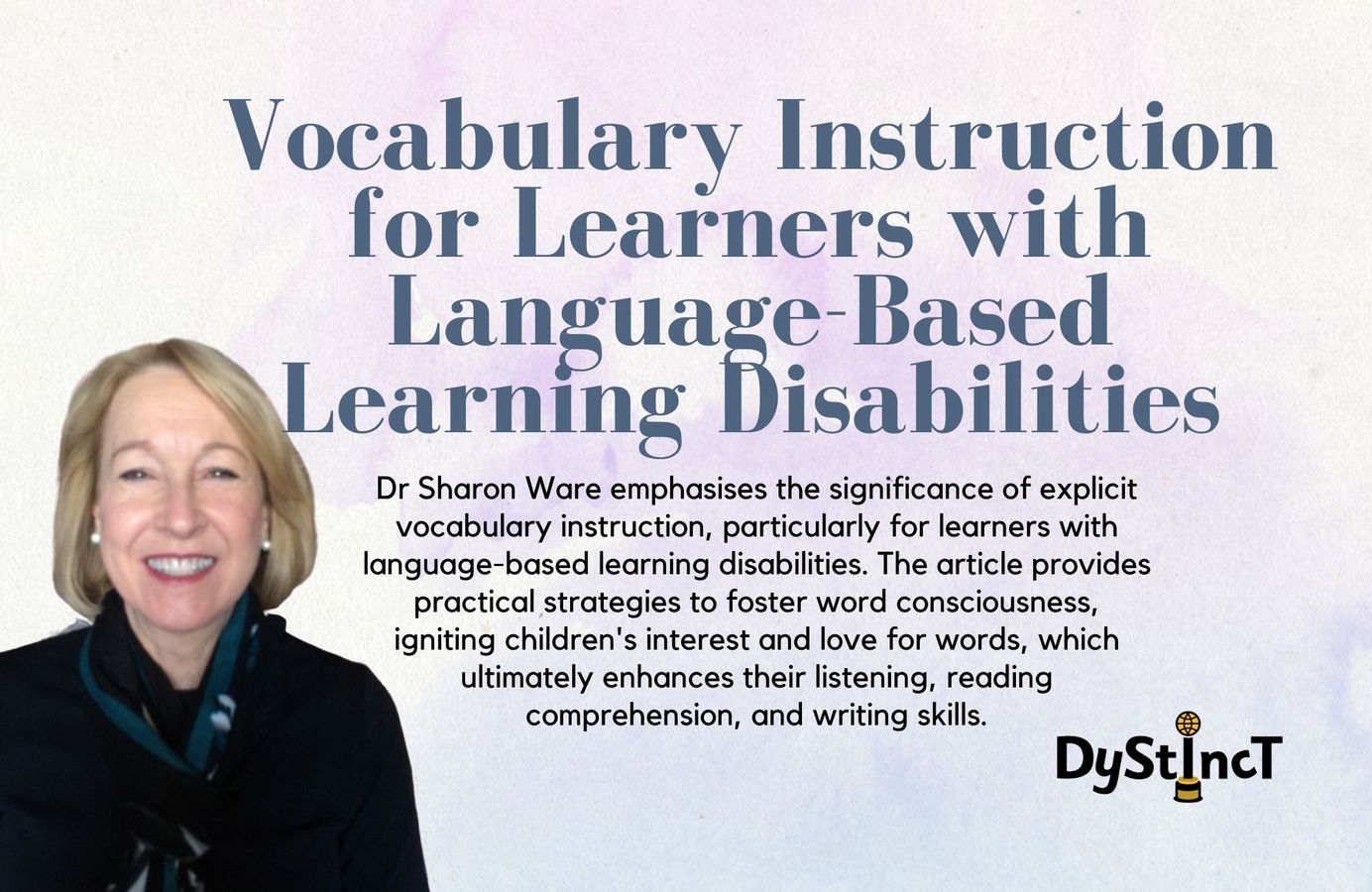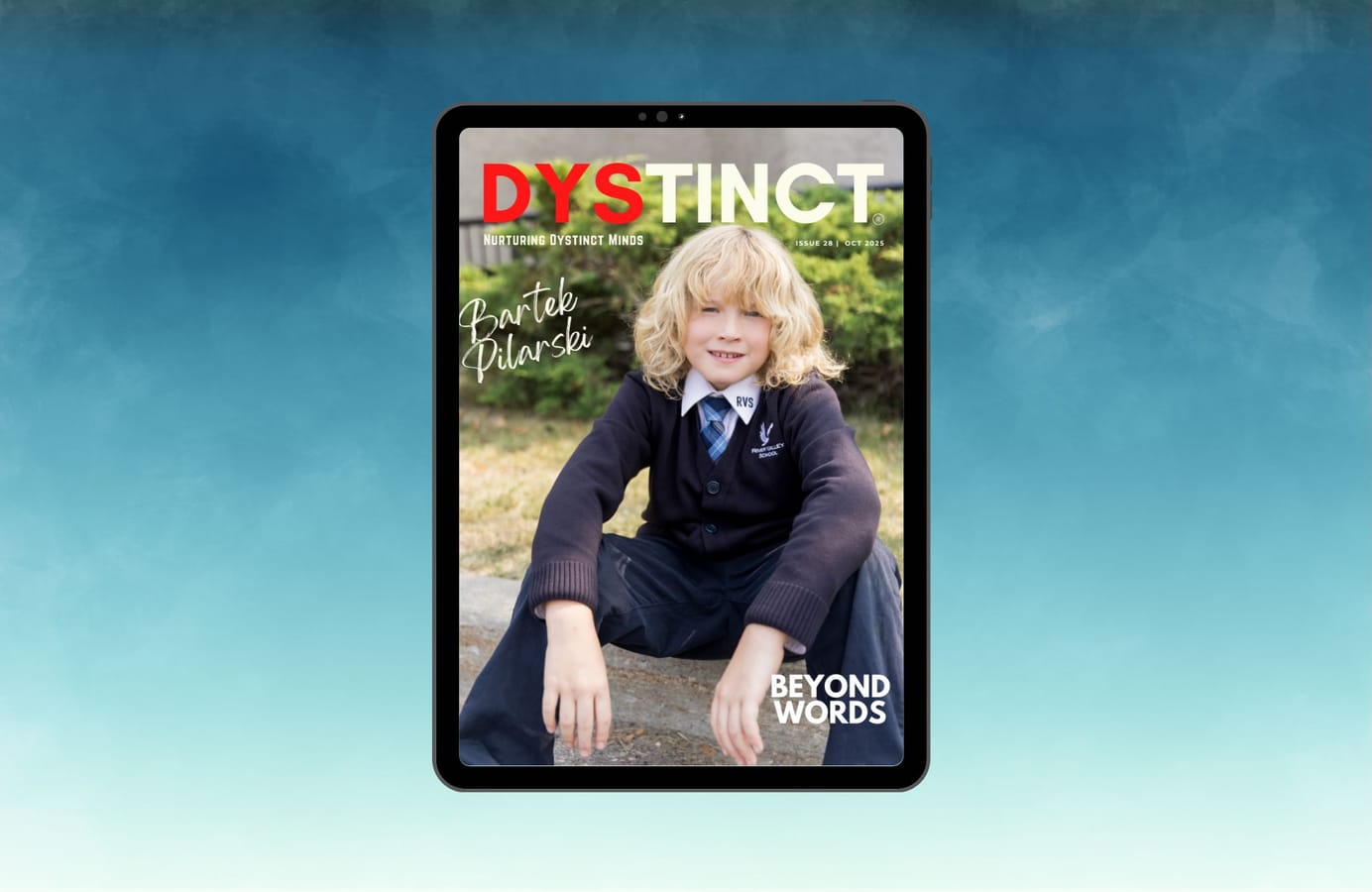
Issue 17: Vocabulary Instruction for Learners with Language-Based Learning Disabilities | Dr Sharon M. Ware
Dr Sharon emphasises the significance of explicit vocabulary instruction, for learners with language-based learning disabilities. She provides practical strategies to foster word consciousness, igniting children's interest and love for words.
Vocabulary plays a crucial role in reading and is important for both decoding and comprehension. Children with strong vocabulary knowledge can identify and remember new words more easily, and word knowledge enables students to understand the overall message of the text they are reading. Children naturally learn many common nouns, verbs, and other parts of speech by listening to the talk of their parents and caregiver; they don't need to be taught simple words like clock, bed, and sister. However, actively helping children, especially those with language-based learning disabilities, build a broad vocabulary and love of words cannot be neglected. Words – spoken and written – are all around us. Teachers and families have an important role in igniting their interest and love for how words can enrich our lives and in teaching children the meaning of specific words. A deep and broad vocabulary supports listening and reading comprehension and enhances children's writing ability. Teachers can also teach strategies that children can use to determine the meaning of words when reading independently.
Building Word Consciousness
Building Word Consciousness
Word consciousness refers to awareness and appreciation of words, how they are used, and their importance in communicating ideas. Interest in words can be part of every day at home and in school; one of the most important things parents and teachers can do to help children become word consciousness is to demonstrate and model an interest in words and wordplay. Something as simple as reciting nursery rhymes and tongue twisters to children builds their awareness of the sound structure of words and that words can be entertaining. Parents and teachers can be mindful of opportunities to use sophisticated and interesting words when speaking to children. For example, instead of saying, "Have a good day!" say, "Wishing you a delightful day!" or "I hope you find today exhilarating!" These simple interactions can help children appreciate the subtleties of word meanings and ignite their curiosity about language. Reading joke books and puns, playing games like Charades and Scrabble, and solving crossword puzzles are fun ways for families to foster word consciousness.
To increase word consciousness, teachers and families can:
- Model using interesting and sophisticated words throughout the day.
- Draw attention to words, their meanings, and their use.
- Read good literature aloud.
- Have fun with words and language.
Ideas for having fun with language
Ideas for having fun with language
Teach Idioms
Explain that idioms are phrases that mean something different from the individual words, like "raining cats and dogs," "she's as cool as a cucumber," and "that work was a piece of cake."
Invite children to share idioms they may have heard. Children can work in groups to:
- Create a drawing of the literal meaning of an idiom.
- Act out the literal meaning AND the figurative meaning for the class.
- See if the class can guess the meaning.
Teach word scales
Word scales, or semantic gradients, are a continuum of words that vary by degree of meaning. For example, "jogging" is faster than "walking." This activity extends children's understanding of antonyms and enhances their ability to make skillful and precise word choices when speaking or writing.
Choose a word like "hot," draw a line, and place the word in the middle.

Have children brainstorm temperature words that fall between cold and hot and hot and scalding. Encourage them to explain why they believe a word belongs in a specific position.
Create a vocabulary notebook
A vocabulary notebook allows children to record new vocabulary words and track new words as they hear them outside of school. The Teaching Reading Sourcebook provides a template for creating a Vocabulary Hot Shot Notebook. Students record new vocabulary with the definition and then look for occurrences of the word in text and conversation, inside and outside school.
Specific Word Learning
Specific Word Learning
Although most words are learned incidentally through conversation and reading, children still require explicit and extended instruction in school. Good vocabulary teaching gets students excited about words and leads them to pay closer attention to new words they hear in conversation and read-aloud stories. Explicit and extended instruction leads to the deep knowledge needed for students to be confident using these words in their writing.
How to select words to teach
One proven method for choosing words for specific instruction is the Three-Tier System designed by Beck & McKeown. Tier One includes common words that typically don't need to be taught, like hot, night, and chair. Tier Three is made up of vocabulary specific to a subject like science or social studies, such as photosynthesis, ecosystem, and federalism. Tier-Two is the hot spot for finding meaningful words for explicit word instruction. These are widely used words that students don't yet know and are likely to encounter across a wide range of reading. Tier Two words are important to comprehension of the text being read and can typically be explained in simple terms using concepts that children understand. The vocabulary chosen for instruction varies by the child's age, but words like enormous, pursue, and collide can be taught and understood by children in their first year of school who understand the concepts of big, chase, and bump!
Where to find words
Children's books provide a rich source of vocabulary words that are new terms for concepts children already know. For example, the young children's book Molly Rides the School Bus by Julie Brillhart uses words like timid, reluctant, and frantic to describe Molly's experience riding a bus for the first time. In Bridge to Terabithia by Katherine Paterson, often read by older children, words appropriate for vocabulary instruction include anticipate, conspicuous, and repulsive.
How to teach tier-two words
Explicit vocabulary instruction is most effective when teachers:
- Provide clear and understandable definitions.
- Use the word in the context of the story and demonstrate use in other contexts.
- Offer students multiple opportunities to interact with words.
- Review words and provide additional learning opportunities.
Provide clear and understandable definitions
-> Provide clear and understandable definitions
Teachers should present meanings of vocabulary words through direct and unambiguous instruction. Meanings should be taught using clear, consistent, and understandable wording. Dictionaries often provide definitions that confuse children, but there are some useful online sources of child-friendly definitions, and teachers can use their creativity to create understandable definitions.
Dictionary Definitions:
-> Sturdy: soundly constructed or constituted.
-> Cottage: a smallish frame dwelling.
Child-friendly Definitions:
-> Sturdy: strong.
-> Cottage: a little house.
Definitions can be reinforced with pictures, examples and non-examples, and gestures, which are especially helpful for second language learners.
Show students pictures that are examples and non-examples of the word. Ask them to give a thumbs-up if the photo matches the word and a thumbs-down if it does not. Have students explain their choices.




Use the word in the context of the story and demonstrate use in other contexts
-> Use the word in the context of the story and demonstrate use in other contexts
When introducing a new vocabulary word, teachers should also provide examples of words used in contexts different from the story.
(From Molly Rides the School Bus)
Remind students that in the story, Molly lost her stuffed animal, Willie, on the school bus: "She took off her backpack and reached for Willy. WILLY WASN'T THERE! She looked frantically all around."
When you are frantic, you are veryupset and afraid. Molly looked around frantically for Willy. Molly felt very upset and afraid when she looked around for Willy, and he wasn't there.
Other things can make us frantic or upset and afraid:
"When I left the door open, and the dog ran away, I was frantic. I was upset and afraid!"
OR
"The campers were frantically trying to put up their tent before the storm came. They were upset and afraid they wouldn't get their tent up before the storm."
Offer students multiple opportunities to use the word
-> Offer students multiple opportunities to use the word
Provide children opportunities to discuss words in extended discourse before and after reading and give them activities that challenge them to process word meanings at a deeper and more complex level.
Let's play a word game. I'll tell you about some things. If you think it is strong, say, "That's sturdy!" If you think it is not very strong, say, "Uh oh, that's not very sturdy!"
• A big jet airplane in the sky.
• A little paper airplane on a windy day.
• A tall tower made of cards.
• Your school.
• A big, huge rock.
• A snowman on a hot sunny day.
Let's talk about our new word, fabulous, which means something is very good and you like it a lot.
• Which word goes with fabulous - okay or super?
Why does super go with fabulous?
• Is it fabulous if you fall and scrape your knee?
What would it be?
• The family had a fabulous time at the park.
Why do you think the family had a fabulous time?
Give students an opportunity to use the word to describe their own experiences.
• Can you tell us something you think is fabulous?
• Let's all look around the room and see how many sturdy things we can find.
• Do you remember a time when you felt reluctant to do something?
This post is for paying subscribers only
SubscribeAlready have an account? Log in


